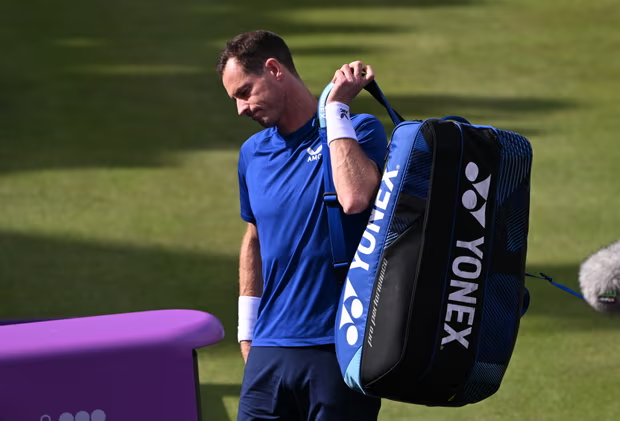
Andy Murray gets medical treatment during a medical time out against Jordan Thompson at Queen’s. Photograph: Clive Brunskill/Getty Images
The final stretch of Andy Murray’s career took a dramatic turn on Wednesday as he was forced to retire from his second-round match at Queen’s Club with a back injury while trailing Jordan Thompson 4-1. The injury means it is unclear whether Murray will be physically ready to compete at Wimbledon for what would likely be a final time.
In the immediate aftermath of the retirement from the match, Murray said he “wouldn’t know” about his prospects of competing. He will undergo tests to determine the extent of his injury and to see what treatment is available to him before the Championships, which begin on 1 July. “I will get scans tomorrow and get it rechecked and see if there’s anything that can be done,” he said.
Murray, a five-time champion at Queen’s Club, had started his tournament with a 6-3, 3-6, 6-3 victory against Alexei Popyrin on Tuesday, which marked his first ATP win since tearing ankle ligaments during a third‑round match at the Miami Open in March. Despite gesturing repeatedly towards his back during the second set, Murray played an excellent third set in a match that seemed to represent real progress.
From his first serve on the opening point on Wednesday, though, it was clear that something was seriously wrong. Instead of leaping back into a split step and chasing down the second ball, Murray remained rooted to the spot and members of the crowd gasped as Thompson’s slow return of serve rolled past him as a winner.
It soon became clear that Murray was unable to move at all and, as the worried audience watched in silence, a retirement quickly seemed inevitable.
Back injuries have been common in Murray’s career, with the Briton undergoing surgery in 2013 and particularly struggling during most clay seasons. After his first‑round defeat at the French Open last month, he revealed he would undergo treatment to address the soreness in his back, something he said he has done before most clay seasons over the past decade. He says the pain had been manageable right up until his pre-match warm-up. He has never before felt the shooting pains down the right side of his back and right leg that followed.

“During my pre-match warm-up, I was pretty uncomfortable, and then just before going on the court, I didn’t have the usual strength in my right leg,” Murray said. “It was not a usual feeling. I don’t know how many of you were watching, but the first two balls I hit in the warm-up, my right leg, it was so uncoordinated. I had no coordination. Then [my] right leg just was not working properly.”
Understandably devastated by his misfortune, Murray quickly packed up his bags and prepared to leave the centre court at Queen’s Club. As he departed, the packed crowd saluted the greatest British tennis player of the Open era with one last standing ovation.
Since the procedure he underwent at the French Open did not directly address the right side of his back, Murray’s hopes of competing at Wimbledon will likely rest on a positive result from his upcoming medical tests and possible treatment of the injury.
“I didn’t necessarily get my right side of my back treated after the French Open, because, like all tennis players, we have degenerative sort of joints and stuff in the back, but it’s all predominantly been left-sided for me for pretty much my whole career. I have never had too many issues with the right side. So maybe there is something that can be done between now and then to help the right side,” Murray said.
Murray has repeatedly said he is unlikely to compete after this summer and either Wimbledon or the Paris Olympics would be the likely venue of his retirement. At the beginning of the week, he was announced as a member of Great Britain’s Olympic team but his hopes of competing in doubles alongside Dan Evans were already in doubt after Evans was also forced to retire from Queen’s with a knee injury.
While Murray’s body has been relatively resilient since the beginning of 2022, this year has been brutal. In March, his torn ankle ligaments came just as he finally appeared to find some form after a difficult start to the season. As he discussed his struggles on court, Murray sought to distinguish the two injuries; while the ankle injury was indeed unfortunate, this was perhaps another sign of his body’s vulnerability after competing for so many years.
“I have tried to work through it and, you know, find ways to get on the court and compete at this level. But tennis is a really, really hard sport,” Murray said.
“Obviously, as you start to age, your body has got a lot of wear and tear in it. You have seen it with Rafa. Novak’s obviously, unfortunately, had the injury recently. Roger, the way that his career finished and some of the problems he had in the latter stages of his career, when you start to play lots and lots of matches, that’s hard. But there is a lot of work that goes into being ready to play and compete at this level. So it’s not easy.”






